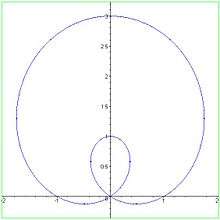Bicorn
- For the hat, see Bicorne.
- For the mythical beast, see Bicorn and Chichevache.

In geometry, the bicorn, also known as a cocked hat curve due to its resemblance to a bicorne, is a rational quartic curve defined by the equation
It has two cusps and is symmetric about the y-axis.
History
In 1864, James Joseph Sylvester studied the curve
in connection with the classification of quintic equations; he named the curve a bicorn because it has two cusps. This curve was further studied by Arthur Cayley in 1867.
Properties

The bicorn is a plane algebraic curve of degree four and genus zero. It has two cusp singularities in the real plane, and a double point in the complex projective plane at x=0, z=0 . If we move x=0 and z=0 to the origin substituting and perform an imaginary rotation on x bu substituting ix/z for x and 1/z for y in the bicorn curve, we obtain
This curve, a limaçon, has an ordinary double point at the origin, and two nodes in the complex plane, at x = ± i and z=1.
The parametric equations of a bicorn curve are:
and with
See also
References
- J. Dennis Lawrence (1972). A catalog of special plane curves. Dover Publications. pp. 147–149. ISBN 0-486-60288-5.
- "Bicorn" at The MacTutor History of Mathematics archive
- Weisstein, Eric W. "Bicorn". MathWorld.
- "Bicorne" at Encyclopédie des Formes Mathématiques Remarquables
- The Collected Mathematical Papers of James Joseph Sylvester. Vol. II Cambridge (1908) p. 468 (online)